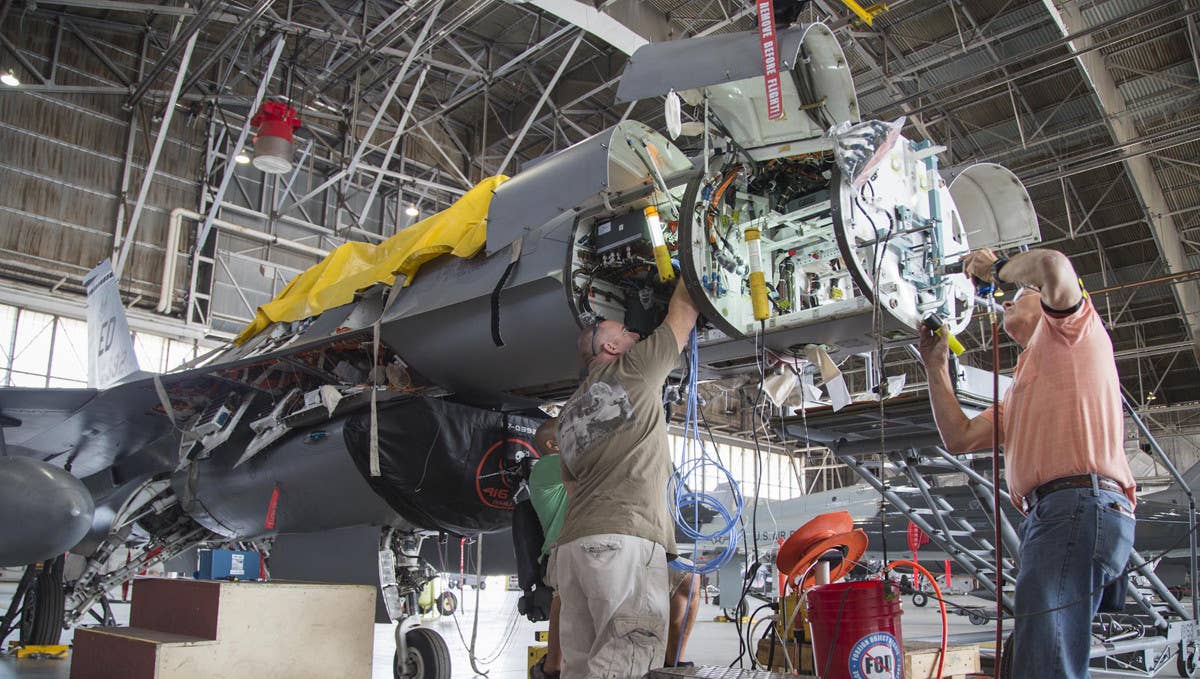The US Air Force intends to fly the F-16 fighter jets for a long time while retiring many others to ration resources for a more combat-capable and combat-ready fleet. The F-16s are undergoing massive upgrades, as part of which the aircraft received state-of-the-art AESA radars recently.
In June 2022, the 72 Air National Guard Block 30 F-16C Viper fighter jets received powerful new AN/APG-83 active electronically scanned array radars as part of a significant upgrade project, according to an announcement from the US Air Force.
The Scalable Agile Beam Radars, commonly known as SABRs, are currently being ordered for hundreds more Air Force F-16s and other Vipers around the globe.
The SABR APG-83 Active Electronically Scanned Array (AESA) fire control radar for the F-16 features cutting-edge features adapted from the company’s family of successful 5th generation fighter AESA radars.
The F-16 can detect, track, and identify more targets faster and at greater distances because of the APG-83’s increased bandwidth, speed, and agility. Additionally, it offers the pilot a broad surface image with all-weather, high-resolution synthetic aperture radar mapping for more accurate target identification and attack.

The F-16 was the main focus when Northrop Grumman started working on the AN/APG-83 more than ten years ago. The AN/APG-80 AESA radar was another AESA radar that the company had previously placed onto F-16E/F models for the United Arab Emirates (UAE).
EurAsian Times had earlier reported that the F-16 fighter jets were geared to receive up to 22 upgrades, and the new SABR radar is part of that program. The overall upgrade initiative intends to make the aircraft more lethal and make sure the fourth-generation fighter can deal with present and potential threats.
An Active Electronically Scanned Array radar, new cockpit displays, a new mission computer, and a new database are a few of the 22 improvements.
The upgrades to the gaining F-16 become imperative in the light of reports indicating that the aircraft will continue to fly for several years. The F-16 is a fourth-generation fighter with the primary responsibility of air dominance and protecting the American homeland against threats.
A Fifth-Gen Radar For Fourth-Gen F-16
AESA radars provide significant advantages regarding target acquisition speed, the range at which threats and potential threats can be detected, and the precision and fidelity of the ensuing tracks, especially for smaller objects.
Lt. Col. Michael Trujillo, commander of the 113th Aerospace Control Alert Detachment of the DC Air National Guard, stated in a release that the F-16’s old mechanical APG-68 fire control radar could only track two targets at once. “I can aim more objects than I can shoot,” he added.
AESA radars are also significantly more reliable, allowing for much more extended periods of uptime besides an improved resistance to jamming is another significant feature. More sophisticated AESAs, including SABR, also offer other enhanced features.
Synthetic aperture mapping, often known as SAR mapping, is a function that the AN/APG-83 can use to enhance its capabilities. As a result, it can generate high-resolution images for surveillance, target acquisition, and identification.
UK To Invests £2.35B To Upgrade Eurofighter Typhoon’s Capabilities For British Royal Air Force – BAE
Cruise missiles and combat drones often fly at low altitudes, making it difficult for standard mechanically scanned fighter radars to detect them. This difficulty is further compounded by the small size, low radar cross-section, and high infrared signature of cruise missiles.
This is where the SABR advanced AESA radar comes in. Notably, the proliferation of cruise missiles exacerbates the security situation, and an advanced radar could easily detect and avert the threat.

“The F-16 Is used extensively by US air National Guard for Homeland defense. It is also used by some US states (Like Texas) air militias. Fitting an advanced radar on the F-16 will improve its capability to engage low-flying stealth cruise missiles such as the Russian X-101. Launched from Russian strategic bombers operating in the Arctic region, X-101 can reach the entire US land mass, said Squadron Leader Vijainder Thakur (retd).
New threats are the main justifications for equipping the aircraft with the new AESA radar. The capabilities of the SABR radar would allow the National Guard to face near-peer adversaries in today’s contested battlespace as current and future threats race to dominate the air domain.
Double Benefit
A small, versatile combat plane, the F-16 Fighting Falcon is exceptionally maneuverable and has a track record of success in air-to-air combat and air-to-surface assault. It gives the United States and its allies access to a high-performance weapon system at a comparatively low cost.
The United States, Belgium, Denmark, the Netherlands, and Norway came together under a program module to build the F-16 under a unique arrangement. Russia’s invasion of Ukraine has thus led to increased sorties by this air dominance fighter jets.
These aircraft that have aged well could be upgraded with this new SABR radar for enhanced performance and security.

“The large number of countries operating the F-16 represents a big market for the upgraded aircraft fitted with radar”, said Squadron Leader (retd) Vijainder Thakur.
It is worth mentioning that Taiwan has purchased many F-16 Viper variants of the F-16s to combat the Chinese threat. Turkey, on its part, has been desperate to upgrade its aging fleet to take on the threat from the Hellenic Air Force of Greece.
Further, the F-16 provides a quantitative edge to the US Air Force. In contrast, fighter aircraft like the Raptor (F-22) and Eagle (F-15) provide the qualitative edge.
Numbers matter when your graphical spread is as large as the American area of interest. The F-16s are also relatively cheaper than other jets in the US Air Force, and many countries around the globe still operate them.
When asked what role the aircraft, now outfitted with advanced radar, would play, Squadron Leader Thakur said that “the F-16 has a role to play wherever the US can establish air dominance/ superiority, which is most of the world! The fighter has a limited range and is not stealthy. Wherever the airspace is not heavily contested, the F-16 can be effective.”
The fighters would also get a Communication Suite Upgrade, a Center Display Unit, a Programmable Data Generator, and several other crucial hardware parts to update the aircraft and next-generation electronic warfare capability. With the fighter expected to stay on, the new AESA radar would be an excellent addition.
- Contact the author at sakshi.tiwari9555@gmail.com
- Follow EurAsian Times on Google News




